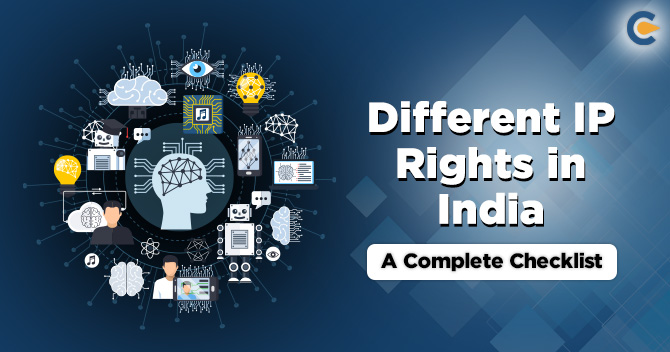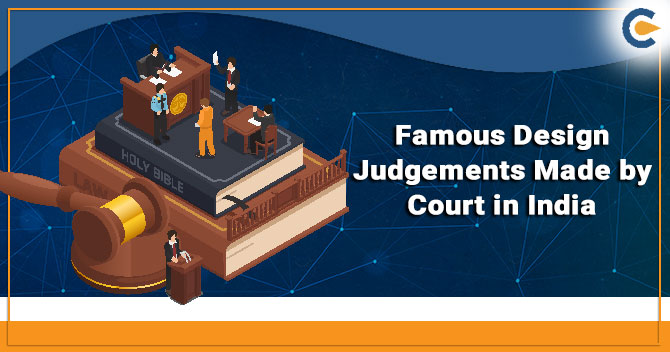The Intellectual Property Rights form the basis of development in a society. The Intellectual Property can be a book, magazine article, Design, or a new way of manufacturing something. There are several forms of IP, but the word Property implies that someone owns it, either by an organization or an individual. The term property signifies that it can get protection under the Law. The IP Rights domain is very vast. The most common applied IP Rights are: Trademark, Copyright, Patent. The understanding of the essential IP Rights is very important nowadays. In this article, we will discuss the difference between the different IP rights in India.
What is IP Rights Law in India?
The IP Rights Law deals with the rules and regulations related to enforcing and securing legal rights to designs, artistic works, and inventions. The primary purpose of IP Law is to give a motivation to people for developing creative works which will benefit the Society. The IP Law also has control over the tangible assets, just as the Law protects the ownership rights of personal Property. The IP Law ensures the people that the development of creative work will grant profit to them.
The IP Rights are not different from other property rights. The IP Rights helps the developer or owner to get benefit from the product as the product was an initial idea which is developed by the owner. The IP Rights also helps the owner to prevent the innovation from dealing, using, or tampering by some other people without the permission of the actual owner. The Law provides for force stop of the illegal use of the innovation, and also, the unlawful user has to compensate for any damages caused.
Hence, it can be said that the IP Rights Law helps in the preservation of the inventions of people from illegal use and also provide the owner the exclusive rights to deal with the innovation.
Read our article:Detailed Process of Patent Registration in India
What are the different types of IP Rights in India?
The different types of IP Rights in India are as follows:


Trademark
A Trademark is a symbol, word, sign, or words by which a business identifies its own products or services and distinguishes them from other products or services manufactured or supplied by other competitors in the market. The primary purpose of Trademark is to establish in the mind of the customer a link between different products or services that the company offers and then differentiate them from other products or services supplied by competitors in the market.
A Trademark can consist of any signs which are capable of being represented graphically, particularly words, including personal names, letters, logos, numerals, the shape of goods, or the packaging of goods. The Trademark provided by the owner of the products or services should be such that the mark is capable of distinguishing the goods or services of one entity from the products or services of other entities.
The owner of the business and product or services file for the Registration of Trademark. The Registration of Trademark enhances the rights of the owner by providing legal evidence and the public of the ownership of the product. A Trademark is proof of the exclusive right of the owner of Trademark and hence, allows the Trademark holder to sue the person infringing the use of Trademark. The Trademark which are registered with the Trademark Registry is authorized to use ® symbol. A Trademark is valid for an unlimited time period, but the Renewal of Trademark is mandatory every 10 years as prescribed under the Trademarks Act, 1999. Therefore, it can be said that a Trademark serves as a symbol of origin for a company, business, or brand in order to communicate that origin to common consumers.
For Registration of Trademark in India, the mark has to satisfy certain conditions. The conditions required to be fulfilled as follows:
- The Trademark should not be generic – A Generic Trademark is a brand name or a mark that has become a common description for a general class of product or service, rather than the specific meaning intended by the holder of Trademark. A Trademark naturally becomes “genericized” when the goods or services with which the Trademark is associated have attained substantial mind share.
- The mark should not be descriptive – Descriptive nature Trademarks are those who clearly describe any aspect, quality, or characteristic of the products or services for which they are used.
- The mark should not be similar or identical to existing marks- A proposed Trademark should not be similar or identical to an already existing registered Trademark with a different owner.
- The mark should not be deceptive – A deceptive Trademark is one that incorrectly indicates the other similar goods or services in the market
Copyright
The main use of Copyright protection is for an original piece of work or a novel. Copyright protection is granted for writings and other forms of expression. The main purpose of protecting the works is to prevent unauthorized copying, distribution, or reproduction of such works. Copyright protection does not protect the idea, but it protects the expression of an idea. Copyright is the least expensive and easiest form of IP Right to obtain. The universal mark use for the Copyright protection is ©. Copyright protection lasts till the person is alive and for 70 years after the death of the copyright owner. Some Copyright protection is automatically created, but it always advisable to register the Copyright with the registering authority of Copyright in India. Any person infringing the use of Copyright can be sued for such an Infringement. The legislation related to the protection of Copyright in India is The Copyright Act, 1957, and the Copyright Rules, 1958[1].
The Copyright protection has mainly two components:
- Moral Rights
These are the rights that are not transferable, and the creator is given the right to be identified as the true author of the work. The exclusive right to any mutilation or distortion of work is also given to the creator of the work.
- Economic Rights
These are the rights that give the owner to control the usage of its creation in any of the ways suitable for the owner. The ways available to the owner are making copies of the work, the performance of work in public, broadcasting, issuing the copies of work to the public. These rights also help in obtaining an economic reward to the owner of the work.
Patent
A
Patent is a title that provides the owner with a right to prevent other people
from ill-using the invention of the owner mentioned in the Patent.
Patent gives the right to exclude other people from using, selling, making, or importing
the patented invention of the owner of the Patent.
A Patent is granted for a specific field in a defined country and only for a
maximum of 20 years. Patent will only be granted if the owner of the invention
does the full disclosure of the invention and publication of the technical
details of the invention. A Patent can protect an invention only for 20
years, and the Renewal of Patent is not allowed. Hence, a Patent comprises of a
deal between Inventors and Society:
In the case of Inventors, a Patent is the primary way to prevent copying of the invention by competitors.
In the case of Society, a Patent embraces on the improvement of the invention process by doing public disclosure of the invention. In return for such public disclosure, investment is encouraged by the delivery of exclusivity of rights and benefits derived from such inventions.
The legislation which deals with the Registration and Protection of Patents in India is The Patent Act, 1970, and The Patent Rules, 2003. The Patent Act, 1970, has undergone three amendments in the years 1999, 2002, and 2005. In the year 2005, an amendment was introduced related to Product Patent Protection for pharma, food, and chemical inventions.
In India to qualify for a Patent, an invention or a product has to satisfy various criteria. The various criteria are as follows:
- New/Novel- The invention should have a feature that sets the invention apart from any previous inventions and is unknown to the public.
- Non-obviousness- The invention’s originality should not be obvious to a person who has some ordinary skills in the area related to the invention.
- Utility- The invention is considered valuable and useful.
Industrial Design
An Industrial Design denotes to a creation of a configuration, shape, or composition or combination of pattern or color in three-dimensional forms comprising of artistic value. The Designs Act in India only protects designs which are aesthetic in nature. An Industrial Design can be a two-dimensional or a three-dimensional pattern. Originality and Novelty are two important criteria for Registration of Design. The Designs which are applied to an article by an Industrial procedure will only be protected.
The Design Rules, 2001 and The Designs Act, 2000, enshrine the Indian Law of Designs. The Registration of Industrial design grants the owner of Design the exclusive rights of importing, selling, and applying the Design to any product. In India, the ‘first to file’ system is adopted. The ‘first to file’ system means that the right holder of the Design should file the Registration application at the earliest point of time. The system helps to rule out any possibility of any other person claiming for the rights of the Intended Designs of the right holder. In India, Registration of Design is valid for a period of 10 years. Design Registration is renewable for a further period of 5 years. Any person can apply for Industrial Design rights. The following conditions are required for a Design to be Registered:
- The Industrial Design should be new;
- The Design should not be published in any other nation;
- The Design should be reproducible by any industrial means;
- The Design should not be against any public order;
- The Design should not contain any obscene material;
- The Design should be distinct from other known Designs.
Geographical Indications
A Geographical Indication refers to an indication which recognizes a good as originating in the territory of a member, or locality or a region in the territory, where the quality, reputation, or any other distinctive characteristic of the good is essentially attributable to the geographical origin of the good.
In India, the Geographical Indications of Goods (Registration & Protection) Act, 1999 and the Geographical Indication of Goods (Regulation and Protection) Rules, 2002, regulates the Registration of Geographical Indications. the owner of an unregistered Geographical Indication can enforce his/her rights through passing off a common law remedy.
What are the advantages of IP Rights?
There are several advantages of safeguarding your Intellectual Property Rights. The advantages are as follows:
- Enhancing the Market Value of Business –
Intellectual Property can generate income for the business of the owner through commercialization, sale, or licensing of protected goods or services. Hence, this can, in return, will improve the market share of owner or raise profits of the owner. In case of merger, acquisition, or sale, the value of the business of the owner will be increased if there is a registered and protected Intellectual Property.
- Turning Ideas into Profit-Making Assets
Ideas generally have a little value on their own. The Registration of Intellectual Property can help the owner to turn ideas into commercially successful goods and services. Registration of Copyright or Patent, for example, can lead to a fixed stream of royalties and supplementary profits that can enhance the business’ bottom line of owner.
- Marketing of Business’ Products and Services
Intellectual Property is important in creating an image for the business of the owner. The owner should think for Trademarks, logos, or the Design of the products or services and get the Registration for the same. Intellectual Property can help the owner in differentiating his/her products and services in the market from the other similar products and services. The Intellectual Property Registration will also in promoting the products and services in the market fearlessly as no one person can illegally use the brand value of the products and services of the owner.
- Raising Finance for Business
The owner of Intellectual Property can monetize the IP assets through sale, licensing, or using the assets as collateral for debt financing. As well as, the owner can use Intellectual Property owned by him/her as a benefit while applying for public or government funding, for example, subsidies, grants, or loans.
- Enhancing Export Opportunities for Business
Intellectual Property can raise competitiveness in the Export Markets. The owner can make use of brands and designs for the marketing of goods and services abroad, search for franchising contracts with foreign companies, or export Patented Products owned by the owner.
The owner can make use of brands and designs for the marketing of goods and services abroad, search for franchising contracts with foreign companies, or export Patented Products owned by the owner.
Conclusion
Over the years, a high-pitched growth is observed in awareness of IP Rights amongst the people of India. Every business almost touches IP Rights and requires the protection of such rights as it safeguards the valuable assets of a business. From the brand name of the company, any invention made by the company, the website company owns; Trademark, Copyright, and Patent not only secure the rights but also prove as an encouragement for better inventive expression. IP Rights are a significant incentive for inspiring people to invest in the development and research of projects universally. Intellectual Property is a wealth-creating
Read our article:Copyright Registration in India – Process, Requirements and Duration











